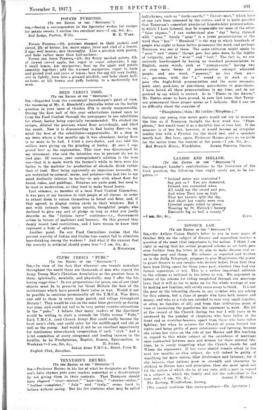TENNYSON'S RHYMES.
fTo rns Emma or THE " Serchtros."1
Sta.—Professor Haines in his list of what he designates as Tenny- son's false rhymes puts your readers somewhat at a disadvantage by not giving them in their contests. That Tennyson should
have rhymed " river—mirror, hair—her," "sweeter—either,' "feather—completer," "July" and "truly." seems hard to believe without seeing. But his list contains what may be called half-rhymes, such as "forth—earth," "Christ—mist," which have at any rate been tolerated by the critics, and it is quite possible that Tennyson's somewhat provincial Lincolnshire pronunciation. to whirls I have listened, may be responsible for some of the other " false rhymes." I can understand also " day " being rhymed with "quay." Surely "quay" is a truer pronunciation of the word than " key." " Hunderd " is the way in which hundreds of people who ought to know better pronounce the word. and perhaps Tennyson was one of them. The sense criticism might apply to " poor " and "shore," though pore has gone down to the depths of vulgarity, and to "wont" and "font." The fact is. we are eeriously handicapped by having no standard pronunciation in English, many words, such as " pomegranate," having two or even more forms of pronunciation amongst educated people, and one word, " gaseous," no less than six- i.e., gaseous, with the "a" sound ns iu dash or in pass (the Anglo-Irish pronunciation and the more onomato- poeic one), gash-foul or gas-shions, gaiss-shions or gone-shious. I have heard all these pronunciations in my time, and do not pretend to say which is correct. As to "Flores in the Axons," Mr. Powles seems to have proved, in your last issue, that Tenny- son pronounced these proper nouns as I indicate. But I can see no difficulty about the scansion of
"Phosphortis I then I 11I6 rldf6a Hespfirtts I."
Certainly our young free metre poets would not try to measure the line as if Tennyson thought the first word was "Phan- plairtie," but would treat it as a dactyllic line of four feet. If the measure is of five feet, however, it would become an irregular iambic line with a Pyrrhic for the third foot, and a spondaic fourth foot. But here, again, Professor Haines gives us no guide for the metre from the context of the poem.-1 am. Sir. Re.,
Red Branch House, Wimbledon. ALFRED PERCEVAL GRAVES.














































 Previous page
Previous page